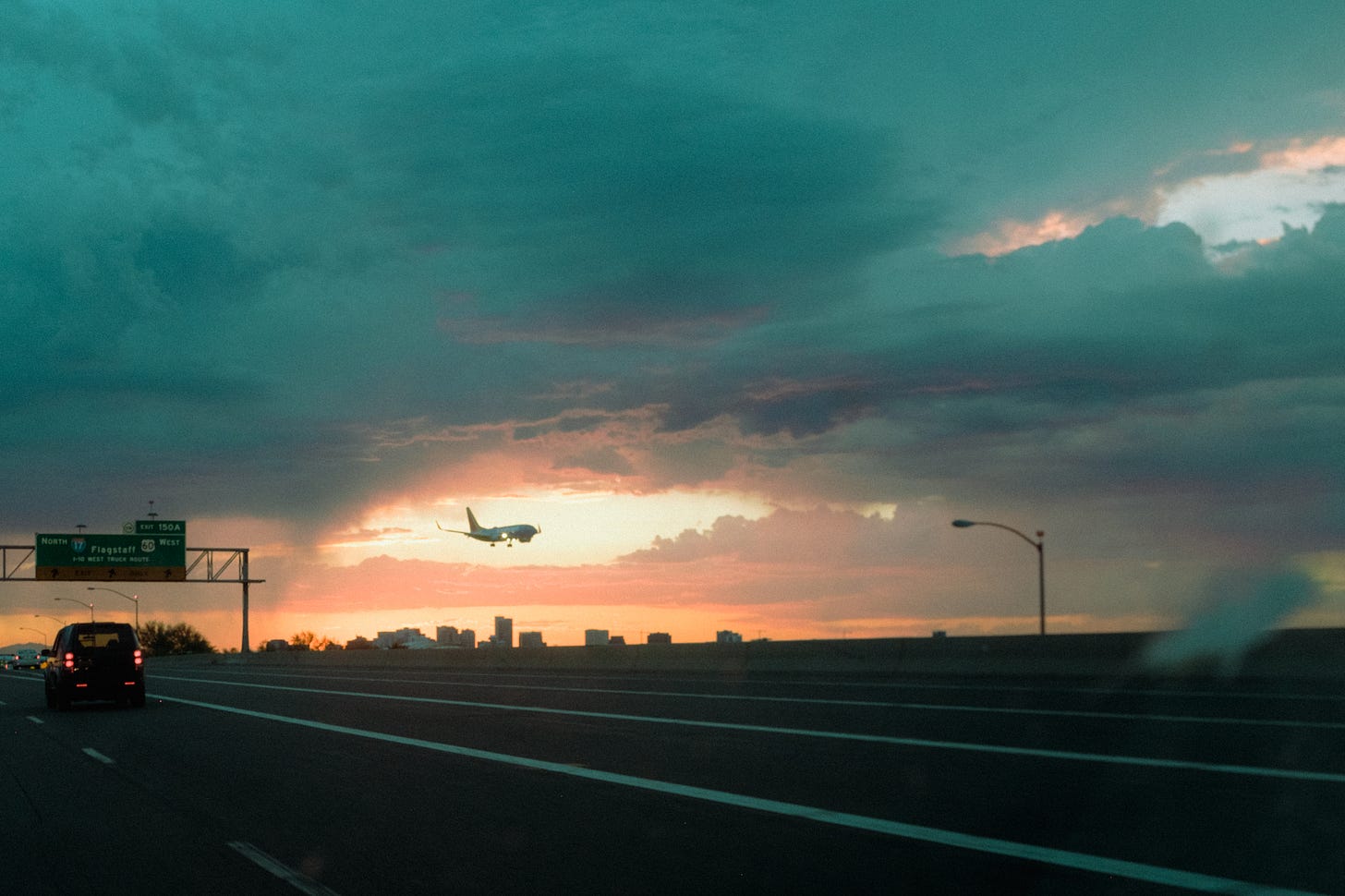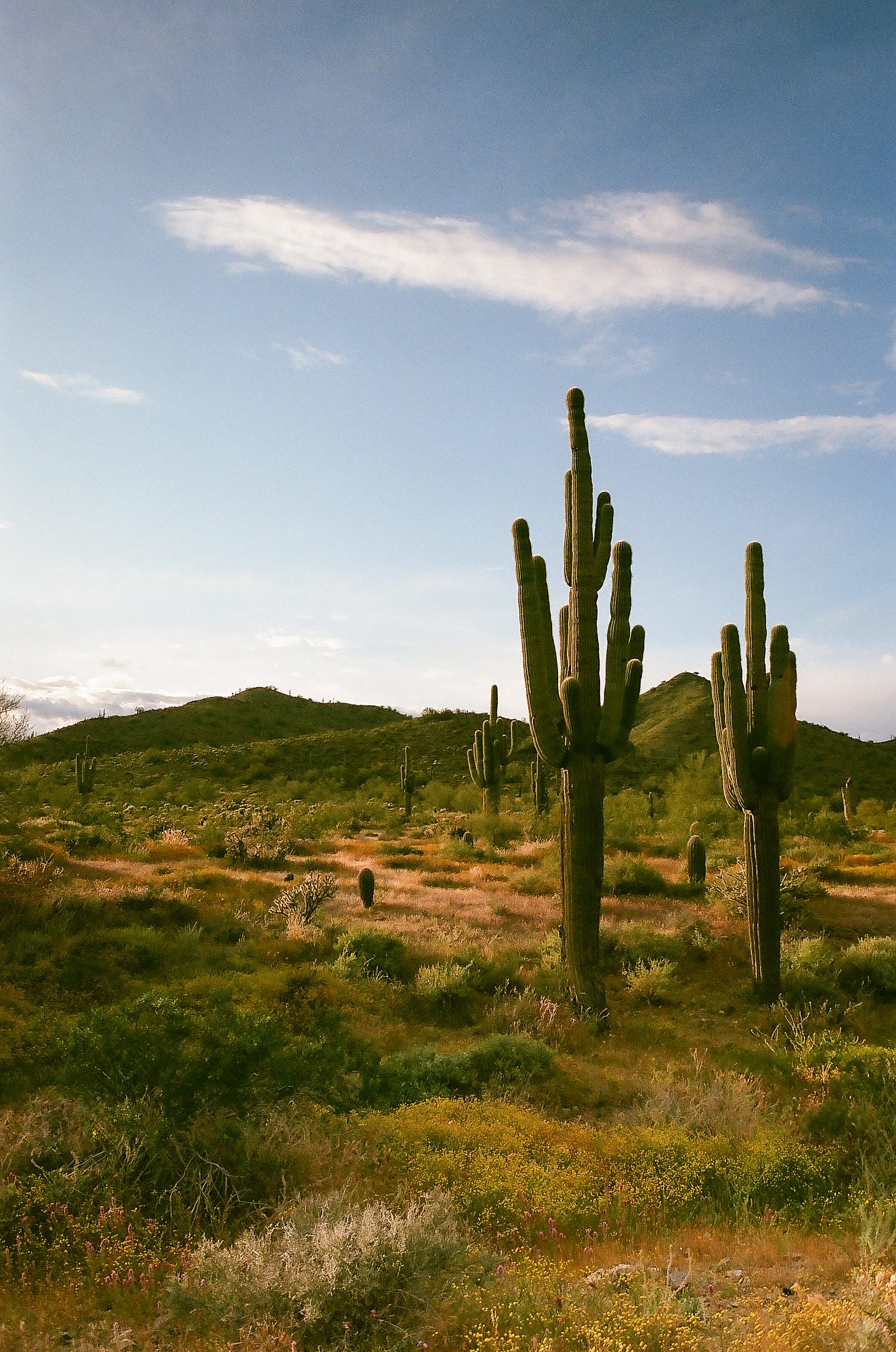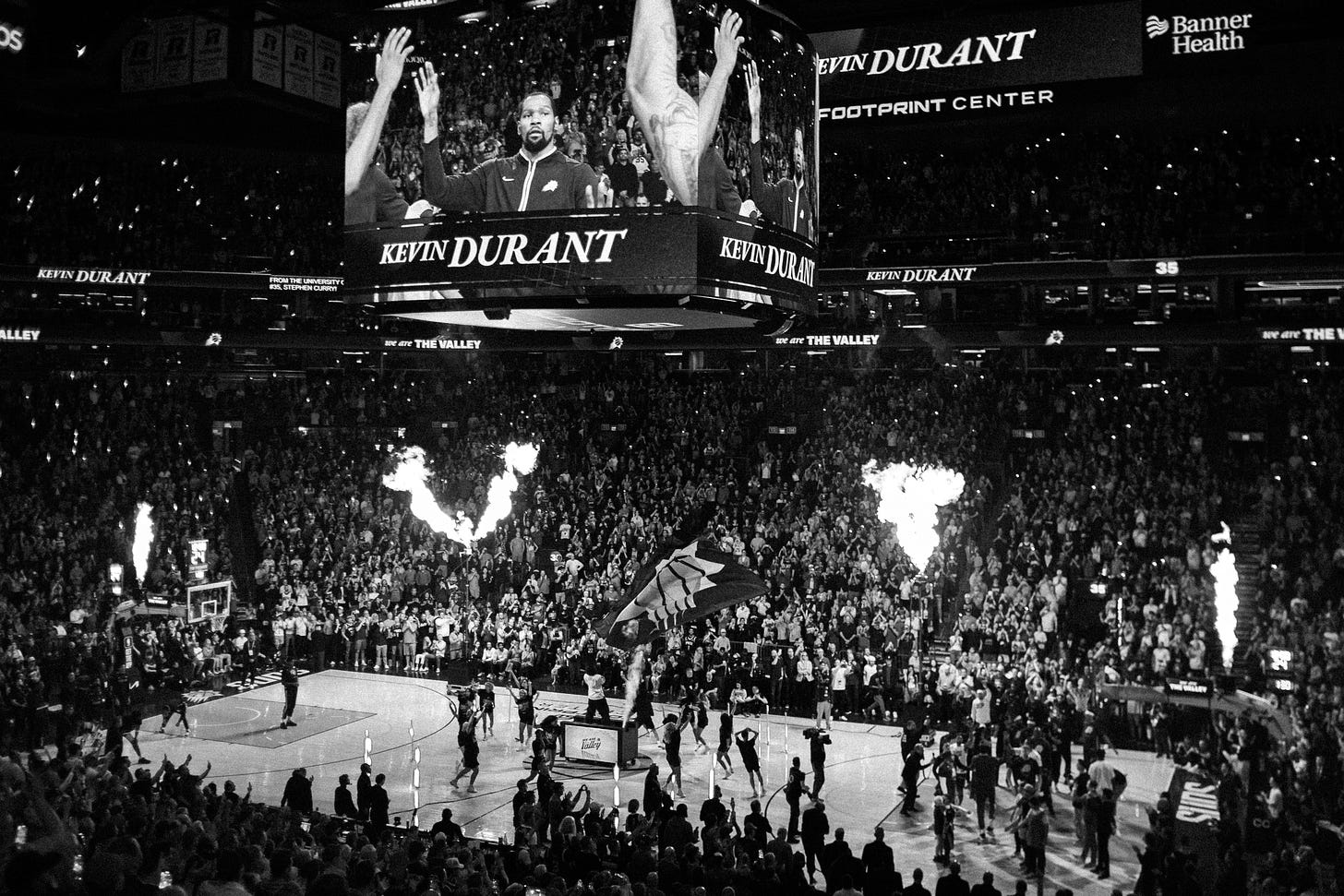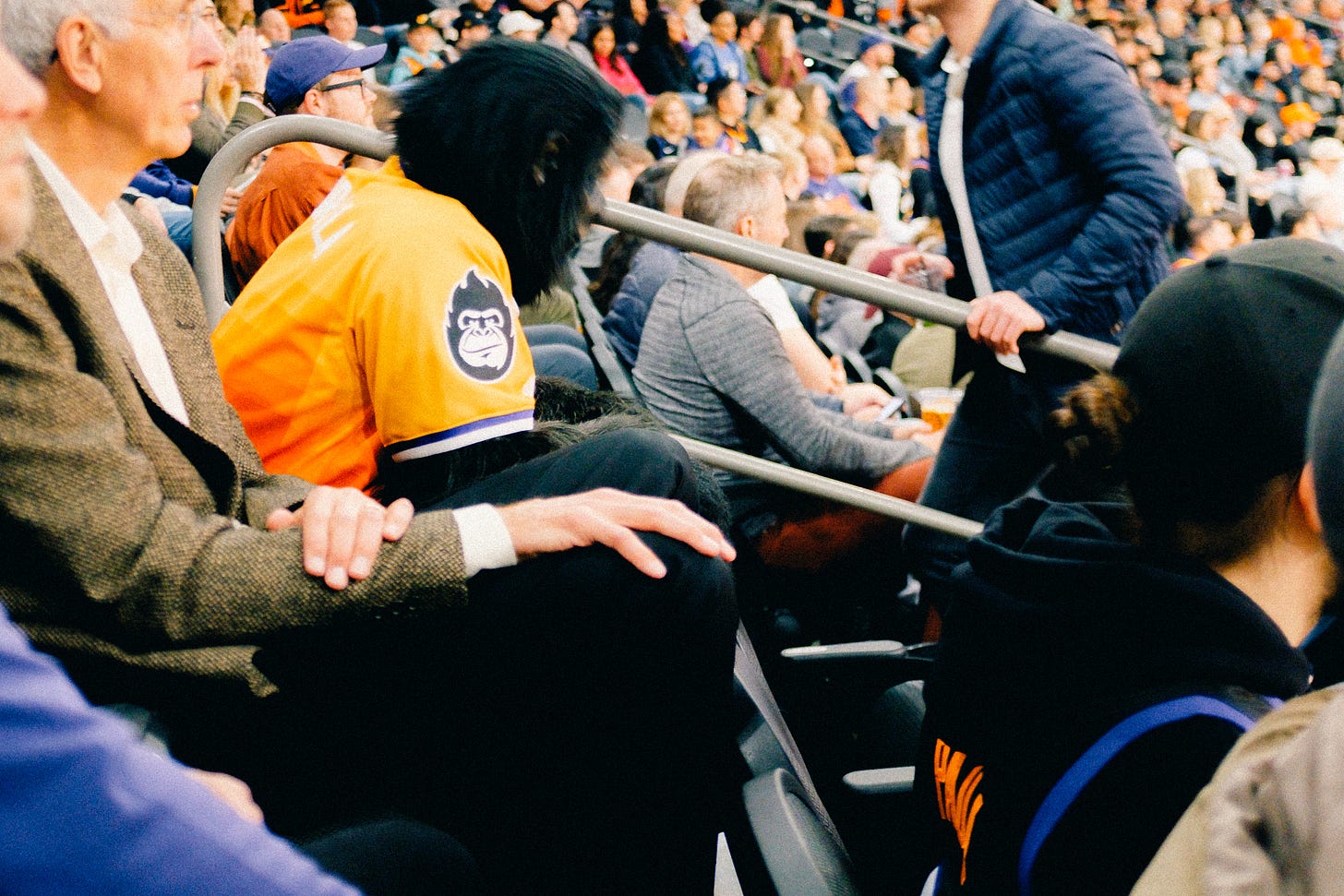Exits: Shoulder season in the Sonoran
Ingenuity, delusion and resilience in the Valley of the Sun.
Phoenix is one of the rare American cities that didn’t borrow its name from an earlier colonizer, though the name itself was chosen because the settlement first surveyed by Jack Swilling in 1867 would come to be built on the Hohokam civilization’s habitation of the area.
Swilling saw remnants of the Hohokam’s 135 mile network of irrigation canals and realized the land, abandoned 400 years earlier after decades of flooding and subsequent drought, could be farmable. It could be born from the ruins of another civilization. This appealed to Swilling, who, after abandoning a wife and newborn in South Carolina for the allure of the gold rush and land up for grabs via forcible indigenous annexation and mass genocide, was clearly a fan of the concept.

According to the United States Census Bureau, Phoenix and its surrounding suburbs span an area of 517.9 square miles. Of that, 516.7 square miles is land — hard-packed clay, sand, sedimentary caliche — and 1.2 square miles, or 0.2%, is water.
The arid, baking land supported the vast, advanced and ancient civilization of the Hohokam for over 1,000 years. The same land that now hosts some 1.63 million people. There’s resiliency in the desert. In the people who chose to make their homes there and in the desert itself. For the people, the resiliency has to skew hopeful. A warm and well-worn hope defiant as it is adept in reorganizing basic facts: How has this land, over centuries, supported life? What’s changed in the way in which we live now? How much of that change has affected the climate of the land where we want to stay living? The reorganization varies depending on personal delusion, ranging from occasional suspension of disbelief to full-time denial, but some variation is required in the desert. Some variation is now required just about everywhere.
The desert’s own resiliency is cold, as is the case with natural laws. For roughly 9,000 years the Sonoran Desert of Arizona has steadily bound the survival of 550+ species of vertebrates and 2,000 or so species of plants to it (and these are just the contemporary head-counts, so likely a lot more over time). Species that have come to thrive over slow years of repetition and slight adjustments in response to the desert’s dispassionate resiliency. What lives, mostly, because of what dies.
It can take a saguaro cactus 50 years to grow a single arm, and some never do. The upper limit of their lifespans is around 150 years, their average height is 40’ tall with some recorded closer to 80’. In Arizona, the only place where the saguaro lives, it’s illegal to remove, shoot at, deface or mutilate the giant cacti, but plenty of people try to transplant them for personal landscaping purposes. Any development that wants to remove one requires a special permit from the state.

In 1982, a man named David Grundman went “cactus plugging”, the colloquial term for shooting at saguaros, with a friend. First, they tore apart a 10’ tall relatively young plant, shooting it in half. Unsatisfied, Grundman spotted a 27’ tall cactus nearby and moved to shoot at it from point blank range with a 16-gauge shotgun.
An arm of the cactus, weighing 500 lbs, fell on and crushed Grundman. Then, the trunk of the cactus fell on him too.
The Palo Verde Nuclear Generating Station sits about 45 miles west of Phoenix. The plant, which generates the largest amount of electricity per year in the U.S., powers Phoenix, Tucson, Las Vegas, Los Angeles and San Diego. The site selection was controversial, being that it was in a spot of naturally occurring westerly winds and placed the metropolitan area of Phoenix immediately in the path of danger, should any accident occur. Also, it was in the middle of the desert. Palo Verde is the only nuclear power plant in the world not located next to a body of water for cooling.
Construction went ahead, mostly because the land belonged to a relative of a prominent Phoenix millionaire, and it was determined the plant would use the evaporated water from the treatment of nearby municipalities’ sewage to cool its tanks.
Delusion, ingenuity and resilience. Safe to say that’s humanity’s big three.
Most NBA owners exist as antithesis to the desert. Impatient, rash, accustomed to bending current circumstance to will (money). Mat Ishbia is ready to terraform this team.
Maybe the one place Ishbia aligns with the Sonoran is in how unsentimental his choices are. But then, the desert doesn’t actually choose. Culling most of Monty Williams’ coaching staff, cutting Chris Paul without a conversation in a trade for Bradley Beal, in the process obliterating most of the remaining resemblance the current team has to its Western Conference Champion predecessor, barely two seasons gone.

Basketball doesn’t tend toward continuity and any parallels it draws from the desert are traditionally bad ones (championship/playoff/winning droughts, competitive wasteland), but Phoenix has a rare stamp in the NBA in that it’s an original (to the city, not to the league) franchise. Part of the NBA’s first expansion, the Suns never switched locations. Since 1968 they’ve been in the desert, and a lot’s grown there. A lot, more recently, has also gone to rot.
After years of complaints of misconduct from some of the most vulnerable people in the Suns organization, Robert Sarver was ousted just this past fall (isn’t that wild, to think it was only six months ago?) There’s plenty to be said, that hasn’t yet in anything I’ve been able to find, about the timing. How the discomfort had been building for years. That women and people of colour in and around the franchise flagged and spoke up about Sarver’s behaviour long before the league let us know it was on their radar and, in comparison to Adam Silver’s speedy ejection of former Clippers owner Donald Sterling, how everything with Sarver seemed stalled to the point of, well, orchestration for profit.
On the surface, Sarver’s departure and its fallout was speedy. Kevin Durant came in, Phoenix landed back in the postseason, Williams and Paul (even if almost half for him was from the sidelines) looked stoic as ever. But the numbers shrivelled, made it look like a team supposed to be so instantly stacked was instead taking a competitive shoulder season.
The Suns offensive rating went from 4th to 14th in the league, pace dropped from 9th to 22nd, and their defensive rating, in case you wonder if they slowed down to improve on that end, went from 3rd to 7th. There was, probably, something festering this season. Something that needed time and heat and exposure to scour, to bleach clean like bones left out in the Sonoran’s shoulderlands.
After 11 seasons without a mascot, the Suns Gorilla came into existence when a singing telegram service sent a man named Henry Rojas in a gorilla costume to deliver a telegram at the team’s first arena. When the delivery was done, and with a game going on, arena security encouraged Rojas to do some dances under the basket during a timeout. The fans were into it, and Rojas kept being invited back to games to perform until he was eventually hired on by the team. He retired in 1988.

There’s the ingenuity of survival and the brain flares that come out of boredom. From extensive networks of hand-dug irrigation ditches by civilizations that have since died out, to a telegram service sending a man in a gorilla suit to deliver an two minute message in song at a basketball arena in the desert because they could, we tend to remember better the things we haven’t always taken for granted.
Ishbia bought something — in NBA terms — very old, a little isolated, and wants for it to compete and thrive as if it’s in another competitive ecosystem, rife with the stuff of life and flexibility of options.
I wonder how readily Beal will fit in, when Durant wasn’t that quick to. I wonder how Devin Booker, steadied and granted new confidence via Paul’s incessant, well-meaning bossiness, will play through Cameron Payne, an abstract, unfortunately frequently injured, de facto point guard. To that end, how Durant and Beal, pros, but best paired with clear direction, will play too.
Williams may have been stubborn, but he was not obstinate. To be determinably tender in a climate that wants to wring you out from inside (the desert, the NBA, the Suns organization under Sarver) is a feat that even natural law will occasionally lay placid at the feat of.


As a suns fan and someone raised in AZ, this one made me smile. Thank you, always, for your work.
Excellent as always!
Especially enjoyed David Grundman's story arc.